Visit the art blog at thematicconversion.tumblr.com and the relog blog at evtrained.tumblr.com.
92 posts
03 Of 05 - Modern Compendium: Kishin Family, Part 3 - UMA Trunko
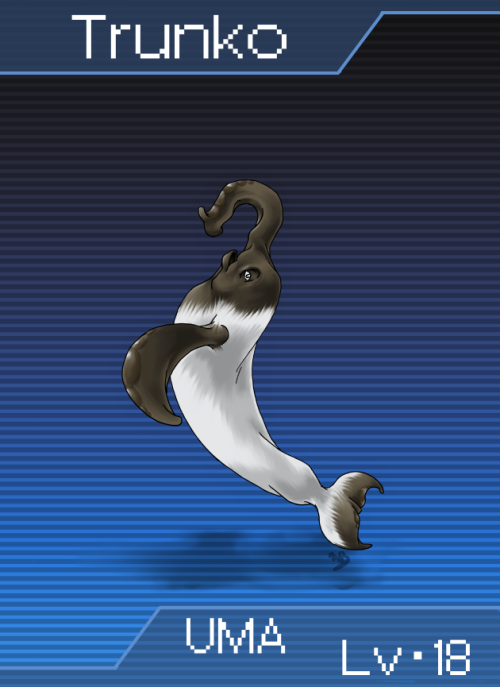
03 of 05 - Modern Compendium: Kishin Family, Part 3 - UMA Trunko
A Cryptid first sighted off the coast of South Africa in 1924, Trunko is an enduringly popular critter, despite very few modern sightings. Perhaps its that ugly-cute coat of fur or the sheer bizarre appeal of an underwater polar bear/elephant/whale hybrid, but either way, this creature is regularly near the top of the list of famous Cryptids.
First seen being attacked by a pair of Killer Whales who battered the animal for three whole hours, Trunko later washed up on the shores of Margate Beach, where it drew a crowd. Beach-goers measured it at 14 feet long, but for some reason, no one managed to get an actual sample of the beast. Heck, to this day there exists only four actual photos of the corpse.
Science, as with so many heavily disfigured Globsters that wash up on shores all over the Earth, is decidedly unimpressed with Trunko. The corpse could easily have been a partially decayed and dismembered whale, especially given the way that tough whale protein “shreds” as it decays, resembling white fur.
Trunko is one of the weaker UMAs, thanks largely to the easy explanations for its appearance and the fact that, despite its popularity, it just doesn’t get seen very much. Its also one of the last UMAs I’ll be designing - there’s only one more to go before this enormous family is done! :o
For more info on this and every other demon in the Modern Compendium, have a look at our Data File, right over (here).
-
 thecringeking reblogged this · 1 year ago
thecringeking reblogged this · 1 year ago -
 thecringeking liked this · 1 year ago
thecringeking liked this · 1 year ago -
 labete-du-gevaudan liked this · 8 years ago
labete-du-gevaudan liked this · 8 years ago -
 alecyard-blog liked this · 8 years ago
alecyard-blog liked this · 8 years ago -
 aria-blazin-it liked this · 9 years ago
aria-blazin-it liked this · 9 years ago -
 hungyhouse liked this · 10 years ago
hungyhouse liked this · 10 years ago -
 historyclasses reblogged this · 10 years ago
historyclasses reblogged this · 10 years ago -
 nagabenang liked this · 10 years ago
nagabenang liked this · 10 years ago -
 turtlesworldofwhut liked this · 10 years ago
turtlesworldofwhut liked this · 10 years ago -
 abstractscarecrow reblogged this · 10 years ago
abstractscarecrow reblogged this · 10 years ago -
 abstractscarecrow liked this · 10 years ago
abstractscarecrow liked this · 10 years ago -
 xerozohar liked this · 10 years ago
xerozohar liked this · 10 years ago
More Posts from Historyclasses
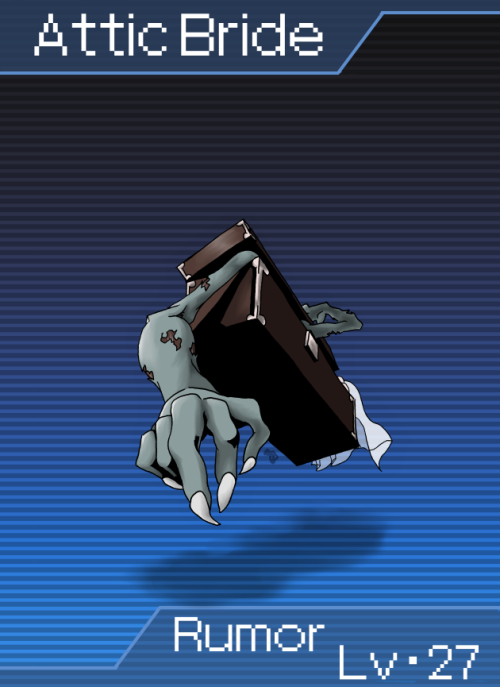
04 of 05 - Modern Compendium: Deity Family, Part 3 - Rumor Attic Bride
A popular and deceptively old urban legend, the story of the Bride in the Attic is one of those stories that gets told around campfires and on Halloween for chills, but not many people actually take it seriously.
The myth itself tells the story of a woman who, after many years of waiting and longing for a husband, fell in love and married the man of her dreams. After a fairy tale wedding, their friends and family treated them to a big house party with all the trimmings. Eventually someone suggested that they play some party games, and they started with Hide and Seek. The bride ran to the attic and hid in an old steamer trunk, and waited for someone to find her.
But no one ever did. The door to the attic had shut behind her, and the trunk had locked as it fell down on top of her. The wedding guests looked and looked, but it wasn’t until years and years later, when her widowed husband finally died, that anyone thought to look in the old trunk in the attic.
The story itself has a huge number of variations. Some versions have the husband as a sinister man who intended the bride to be locked in the attic, but he never gets his hands on her wealth because her vengeful spirit comes back to haunt him. Other versions have the husband himself finding the bride weeks or months later, as she begins to smell. Often a beating heart or spooky thumps on the ceiling are involved. But the most common alteration to the story is the city in which it happens; most people make sure the story takes place “just down the road” or “in a town just like this one” for maximum fireside spookies.
The Attic Bride fits easily into the Rumor family, but because it’s not a story that many people take very seriously, it’s not a particularly powerful demon. She is one of the few Rumors that is weak to Dark, though, so the Bride does have one unique thing to her credit.
For more info on this and every other demon in the Modern Compendium, have a look at our expanding Data File, right over (here.)
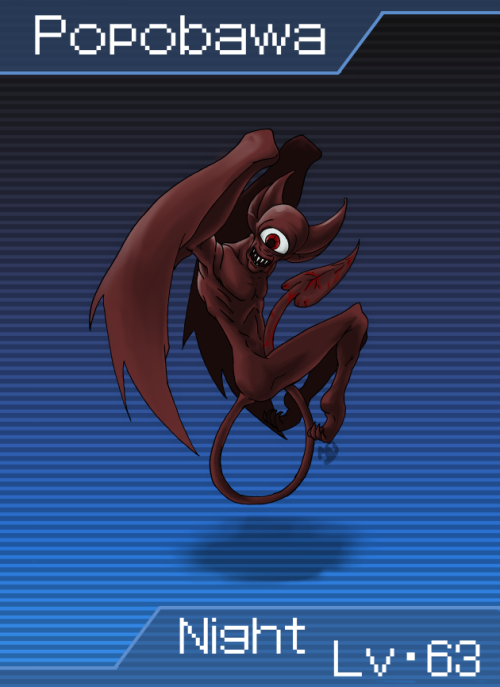
01 of 05 - Modern Compendium: Kishin Family, Part 5 - Night Popobawa
The mythology of Tanzania, an African country on the eastern coast of the continent, is a fascinating mix of ideas from Christianity, Islam, and myriad native folk religions. In modern times, these ideas have combined with politics and western Cryptozoology to create a truly novel demon known as the Popobawa.
The characteristics of the Popobawa are actually fairly similar to the Incubus of ancient Christian belief; a dark spirit, sometimes summoned by a sorcerer, to sexually assault people, usually women, in their sleep. However, the Popobawa is said to be a shapeshifter, only recognizeable by its bat-winged shadow – in fact the name “Popobawa” actually translates to “bat wing.” The creature is also said to be responsible for Poltergeist-like activity in homes and other physical attacks.
Popobawa reports have been responsible for several mass panics in Tanzania’s history, the most recent being in 2007. A couple of odd quirks in the creature’s mythology have helped this along; first, the idea that a Popobawa’s attacks can only be stopped by telling someone about them; and second, the fact that these reports multiply during election season. That’s right, there is a distinct possibility that we are looking at politically motivated fear mongering in the shape of a shadowy cycloptic man-bat. At least it’s more straightforward than color-coded terror charts, I guess.
At any rate, the Popobawa rates pretty high in the Night family, largely thanks to the heights of terror it inspires in populations that believe in it. Mechanically, it actually takes the place of the Succubus as the go-to Charm-based sex demon, though it is of course a bit more physically specialized.
For more info on this and every other demon in the Modern Compendium, have a look at the Data File, right over (here)!
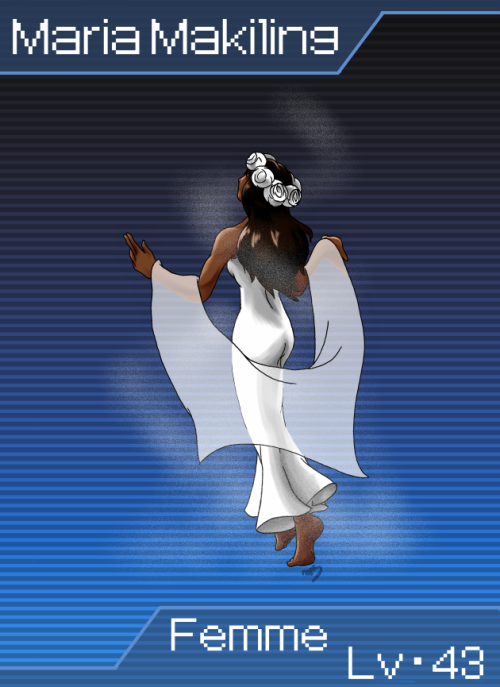
05 of 05 - Modern Compendium: Deity Family, Part 2 - Femme Maria Makiling
A major figure in the folk mythology that surrounds Mount Makiling in the central Philippenes, Maria Makiling is what is known as a Diwata, nature spirits roughly analogous to a nymph or fairy. Maria herself has roots that go back to the native cultures that inhabited the islands of the Philippenes before the European invasions, but as far as we can tell, she has always been seen as a protector of the mountain and surrounding areas.
What I find fascinating about Maria Makiling is how little the modern world has changed her. People that live around Mount Makiling still report seeing a dark haired, dark skinned woman in white wandering the wilderness, aiding those who respect and revere nature, and cursing those who despoil it. She’s even said to confuse those who don’t clean up after their campfires and picnics, turning the forest into an inescapable maze until they tidy up after themselves.
As an eternally young woman who is constantly pursued, but who only allows those she deems worthy to find her, Maria Makiling is eminently suited to the Femme family. Her kind nature does make her a bit of an unusual figure in the normally very offensively-focused Femme family; she’s more interested in healing spells and a few status effects than in actually dealing damage.
For more info on as well as links to every demon in the Modern Compendium, have a look at our extensive Data File, right over (here).
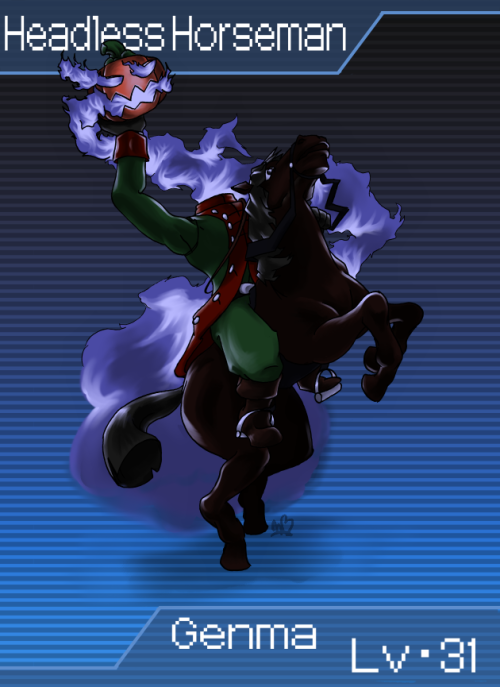
01 of 05 - Modern Compendium: Deity Family, Part 4 - Genma Headless Horseman
Holy crap that took a lot longer than I expected. I did not have a full appreciation for the complexity of this design. @_@
But yes! The Headless Horseman! Introduced to the United States in the early 19th century by Washington Irving’s The Legend of Sleepy Hollow, the Horseman is based on a long-standing tall tale that has surprisingly deep roots in history. Irving’s version of the Headless Horseman is said to be the ghost of a Hessian mercenary who had his head blown off by cannon fire in the Revolutionary War, but there are tales of Horsemen as far back as the Middle Ages. In fact, there’s a good chance that early tales of headless riders were inspired by the long-standing Irish fairy story of the Dullahan, an animated suit of armor that rode a black steed through the countryside, and who could kill simply by speaking the victim’s name.
The Legend of Sleepy Hollow has always been a popular American myth, especially around Halloween, and its impact on pop culture is pretty easy to see. The Horseman appears on Halloween-themed merchandise every year, there’s a popular Disney short about him – hell, there are even high school football teams that have the Horseman as a mascot, and if that doesn’t say mainstream acceptance, I don’t know what does. The Headless Horseman is unique in one interesting way, though; it is one of the few Halloween monsters that have been able to resist the slide into kitsch. You might see cutesy ghosts and witches at Halloween, for example, but a cute Horseman is pretty rare.
As a uniquely American monster, the Headless Horseman fits neatly into the Genma family. He is right at the bottom, but the Horseman is a powerful demon for its level, and would probably qualify as one of the early special Fusions.
For more info on this and every other demon in the Modern Compendium, have a look at our extensive Data File, right over (here).
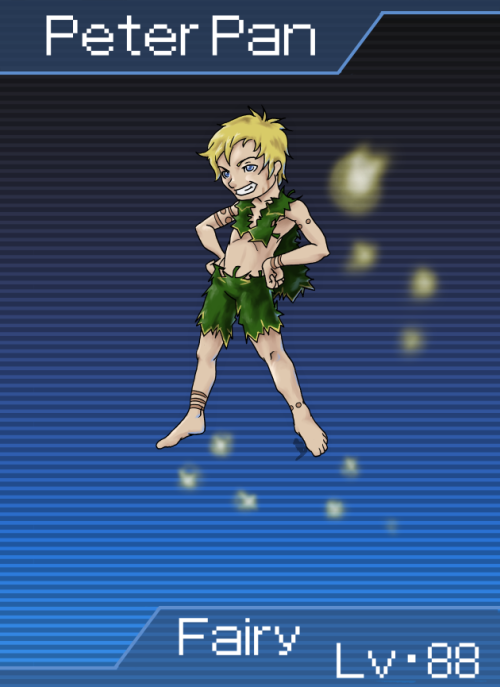
03 of 05 - Modern Compendium: Deity Family, Part 2 - Fairy Peter Pan
Though most people today know this fey youth through the popular Disney film, Peter Pan actually started out life as the brainchild of a Scottish novelist named J. M. Barrie. Barrie based Peter in large part on his older brother, who died at a very young age, but large parts of the character were also influenced by traditional fairy stories. In particular, Peter was supposed to have “left” his parents as a baby, only to come back later and find another child in his place, an element that strongly resembles the stories about Changelings, creatures of fae origin left in place of human children. And of course the idea of an eternally young human raised by fairies is a fairly common motif in fairy stories.
Like Jack Frost, Peter Pan has experienced a significant increase in popularity thanks to his inclusion in the canon of popular culture. These days, most people see Peter as a slightly mischievous, but usually heroic figure. However, his initial characterization was a bit more complex. Written as an exaggerated stereotype of a boastful and arrogant child, the original Peter Pan more or less personifies the arrogance of youth. One way this surfaces is in the way Peter retains his immortality, sacrificing his memories and experiences in order to remain young.
Peter was a pretty challenging demon to design, thanks to the great influence Disney has had in molding ideas about him. It was difficult to come up with a design that would include that source as an influence, but still look like it fit in a Shin Megami Tensei universe. In the end, I tried to go for a design that emphasized Peter’s feral arrogance, but still retained some whimsy and humanity.
Peter’s near ubiquity in the cultural lives of children means he’s a very robust figure in the Fairy family, coming in right at the top. He gets some very strong skills, but thanks to the Fairy family’s low power overall, he’s not overwhelming. I like to think Peter would be one of your first real end-game demons.
For more info on this and every other demon in the Modern Compendium, have a look at our Data File, right over (here)!